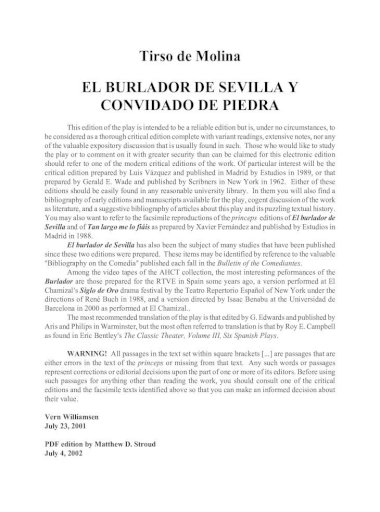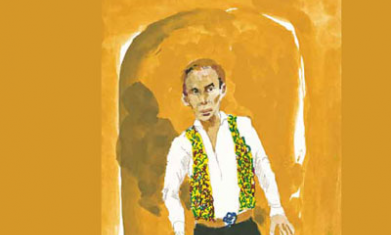

- #El burlador de sevilla english translation full text download#
- #El burlador de sevilla english translation full text free#

El burlador de Sevilla y convidado de piedra was first published in Spain around by Gabriel Tellez, a Spanish Baroque dramatist, poet. Mar 10, El burlador de Sevilla (), Tirso de Molina Don Juan, The Trickster of Seville translated by Dakin Matthews The Lady-Killer of Seville and His Graven Gwynne Edwards bilingual edition in English and Spanish. The Trickster of Seville and the Stone Guest (Spanish: El burlador de Sevilla y convidado de piedra) is a play by Tirso de Molina. El burlador de Sevilla by Tirso de Molina.
#El burlador de sevilla english translation full text download#
█ ► READ The Trickster of Seville and His Guest of Stone by Tirso de Molina █ ► ONLINE The Trickster of Seville and His Guest of Stone by Tirso de Molina █ ► DOWNLOAD The Trickster of Seville and His Guest of Stone by Tirso de Molinaĭescription book The Trickster of Seville and His Guest of Stone by Tirso de Molina: El burlador de Sevilla (1616-1625).:, The Lady-Killer of Seville and His Graven Guest, Or: To Death with Bated Breath, translated by Michael Kidd ACT ONE Scene One Context: This is the beginning of the play, just before daybreak in a room near the King's chambers in the Royal Palace, Naples. 'Largo al Factorum,' Figaros opening aria in the operas first act, is considered one. of El burlador de Sevilla and Cahier dun retour au pays natal.
#El burlador de sevilla english translation full text free#
Its based on the first play of 'Le Barbier de Seville,' the three-part story of Figaro written by French playwright Pierre Beaumarchais. Special issue of Translation and Translanguaging in Multilingual Contexts 2:2 (2016). Its a fast moving play with several themes intertwined: the theological problem of grace, free will and predestination, good and evil, actions and consequences. Start by marking El Burlador De Sevilla as Want to Read: Rate this book. Goodreads helps you keep track of books you want to read. The earliest adaptation of the legend of Don Juan, the personification of youthful indifference and all that is sinful, Tirso’s tale set in the. This kind of translations could in fact serve as maps to allow readers to orientate in the original text, and to bring it further, to unpredictable destinations, rather than simply reproducing a copy of the original in another language.READ BOOK "The Trickster of Seville and His Guest of Stone by Tirso de Molina" online thepiratebay sale cheap mobile book █ ► READ The Trickster of Seville and His Guest of Stone by Tirso de Molina █ ► ONLINE The Trickster of Seville and His Guest of Stone by Tirso de Molina █ ► DOWNLOAD The Trickster of Seville and His Guest of Stone by Tirso de Molina 'The Barber of Seville' (Italian: Il barbiere di Siviglia) is a comedic opera by Giachino Rossini. The full title of the play is El Burlador de Sevilla y Convidado de Piedra (The Trickster of Seville and the Stone Guest).It is the first significant literary version of the Don Juan legend. El burlador de Sevilla y convidado de piedra was first published in Spain around 1630 by Gabriel Tellez, a Spanish Baroque dramatist, poet and a Roman Catholic monk who used the name Tirso de Molina. Looking at these two different kinds of adaptation, I will try to reach a new understanding of creolized and creolizing translation. The Trickster of Seville is thoroughly representative of the drama of Spains Golden Age: a drama of fast-moving action which set its face against classical precepts, broke the unities of time and place, cheerfully mixed the serious and the comic, combined main and sub-plots, and cultivated Spanish subjects and Spanish characters. After a discussion of all the meanings these terms carry, the article will focus on two works by Derek Walcott: his rewriting of Tirso De Molina’s El burlador de Sevilla, and his unpublished translation of Aimé Césaire’s Cahier d’un retour au pays natal, to understand what directions these works have taken through Walcott’s intervention. This article is a study of the proximity between the processes of creolization and translation, which share the opportunity of bringing our languages, our cultures and our literatures to a creative encounter.

Localización: Translation and translanguaging in multilingual contexts, ISSN-e 2352-1813, ISSN 2352-1805, Vol.


 0 kommentar(er)
0 kommentar(er)
